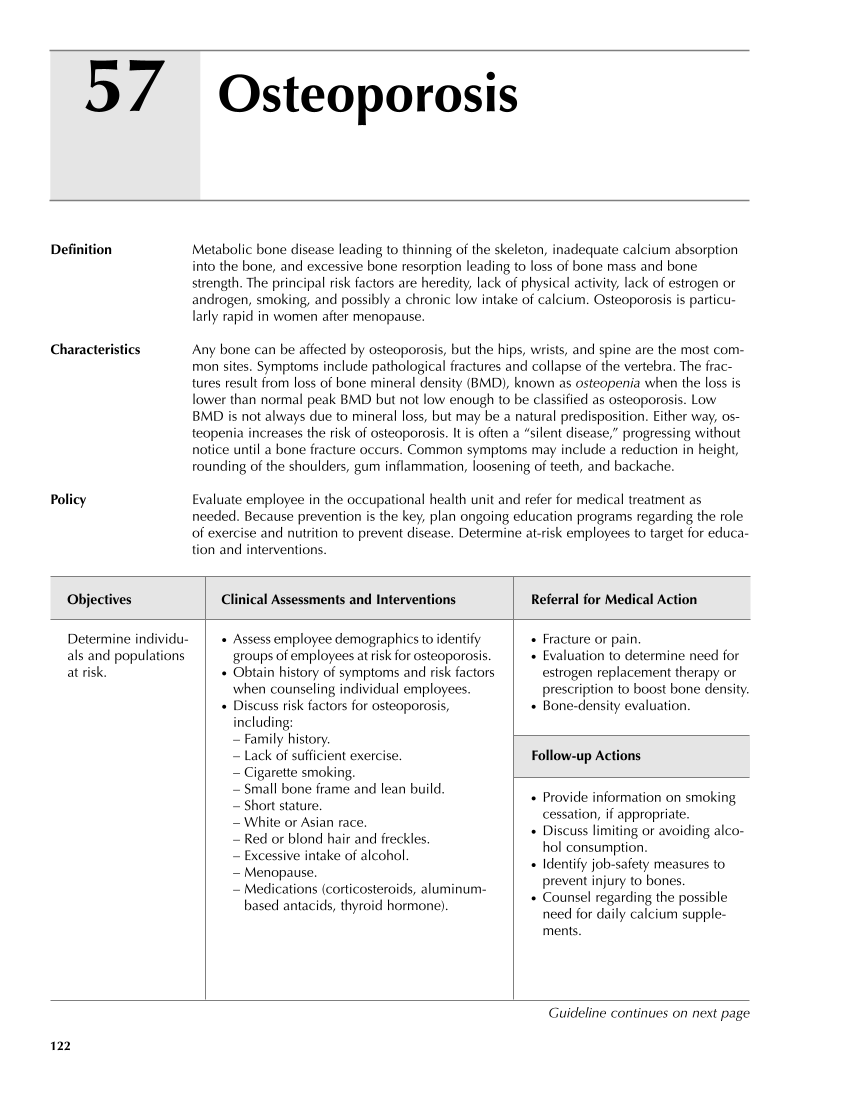57 122 Definition Metabolic bone disease leading to thinning of the skeleton, inadequate calcium absorption into the bone, and excessive bone resorption leading to loss of bone mass and bone strength. The principal risk factors are heredity, lack of physical activity, lack of estrogen or androgen, smoking, and possibly a chronic low intake of calcium. Osteoporosis is particu- larly rapid in women after menopause. Characteristics Any bone can be affected by osteoporosis, but the hips, wrists, and spine are the most com- mon sites. Symptoms include pathological fractures and collapse of the vertebra. The frac- tures result from loss of bone mineral density (BMD), known as osteopenia when the loss is lower than normal peak BMD but not low enough to be classified as osteoporosis. Low BMD is not always due to mineral loss, but may be a natural predisposition. Either way, os- teopenia increases the risk of osteoporosis. It is often a “silent disease,” progressing without notice until a bone fracture occurs. Common symptoms may include a reduction in height, rounding of the shoulders, gum inflammation, loosening of teeth, and backache. Policy Evaluate employee in the occupational health unit and refer for medical treatment as needed. Because prevention is the key, plan ongoing education programs regarding the role of exercise and nutrition to prevent disease. Determine at-risk employees to target for educa- tion and interventions. Objectives Clinical Assessments and Interventions Referral for Medical Action Osteoporosis ● Fracture or pain. ● Evaluation to determine need for estrogen replacement therapy or prescription to boost bone density. ● Bone-density evaluation. Follow-up Actions ● Provide information on smoking cessation, if appropriate. ● Discuss limiting or avoiding alco- hol consumption. ● Identify job-safety measures to prevent injury to bones. ● Counsel regarding the possible need for daily calcium supple- ments. Determine individu- als and populations at risk. ● Assess employee demographics to identify groups of employees at risk for osteoporosis. ● Obtain history of symptoms and risk factors when counseling individual employees. ● Discuss risk factors for osteoporosis, including: – Family history. – Lack of sufficient exercise. – Cigarette smoking. – Small bone frame and lean build. – Short stature. – White or Asian race. – Red or blond hair and freckles. – Excessive intake of alcohol. – Menopause. – Medications (corticosteroids, aluminum- based antacids, thyroid hormone). Guideline continues on next page
Purchased from OEM Press by (ge corporate access). (C) 2013 OEM Health Information, Inc. All rights reserved.












































































































































































































































































































































































































































